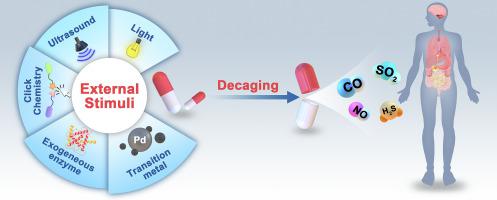Journal of Controlled Release ( IF 10.5 ) Pub Date : 2022-09-20 , DOI: 10.1016/j.jconrel.2022.09.026 Xingyue Ji , Zhiyuan Zhong

|
Gasotransmitters like nitric oxide, carbon monoxide, and hydrogen sulfide with unique pleiotropic pharmacological effects in mammals are an emerging therapeutic modality for different human diseases including cancer, infection, ischemia-reperfusion injuries, and inflammation; however, their clinical translation is hampered by the lack of a reliable delivery form, which delivers such gasotransmitters to the action site with precisely controlled dosage. The external stimuli-responsive prodrug strategy has shown tremendous potential in developing gasotransmitter prodrugs, which affords precise temporospatial control and better dose control compared with endogenous stimuli-sensitive prodrugs. The promising external stimuli employed for gasotransmitter activation range from photo, ultrasound, and bioorthogonal click chemistry to exogenous enzymes. Herein, we highlight the recent development of external stimuli-mediated decaging chemistry for the temporospatial delivery of gasotransmitters including nitric oxide, carbon monoxide, hydrogen sulfide and sulfur dioxide, and discuss the pros and cons of different designs.
中文翻译:

外部刺激响应性气体递质前药:化学和时空释放
一氧化氮、一氧化碳和硫化氢等气体递质在哺乳动物中具有独特的多效药理作用,是治疗癌症、感染、缺血再灌注损伤和炎症等不同人类疾病的新兴治疗方式;然而,由于缺乏可靠的输送形式,它们的临床转化受到阻碍,该输送形式以精确控制的剂量将此类气体递质输送到作用部位。外部刺激响应前药策略在开发气体递质前药方面显示出巨大潜力,与内源性刺激敏感前药相比,该策略可提供精确的时空控制和更好的剂量控制。用于气体递质激活的有希望的外部刺激范围从照片、超声波和生物正交点击化学到外源酶。


















































 京公网安备 11010802027423号
京公网安备 11010802027423号